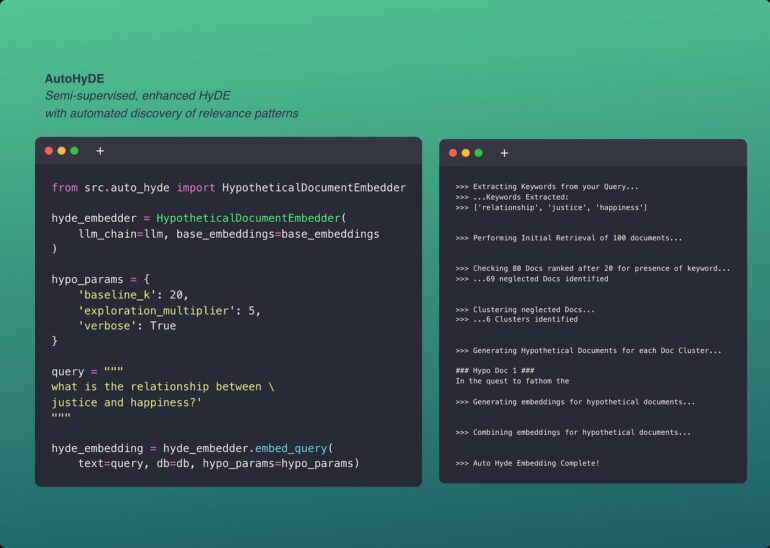- AutoHyDE advances conversational AI by enhancing response generation in LLMs and RAG.
- It builds upon the HyDE framework, automating dialogue exploration and optimization.
- The approach utilizes genetic algorithms, neural architecture search, and hyperparameter optimization.
- AutoHyDE adapts to diverse contexts and user preferences without manual intervention.
- It improves response quality, coherence, and diversity over time, even in multi-turn conversations.
- The solution reduces the burden of manual tuning for developers and researchers.
- AutoHyDE offers scalability and adaptability for deploying conversational agents across domains.
Main AI News:
In the realm of artificial intelligence (AI), particularly within the domain of Large Language Models (LLMs) and Response Generation (RAG), AutoHyDE emerges as a transformative force. This groundbreaking innovation builds upon the foundation of the established HyDE framework, employing automated methodologies to elevate its functionalities and achieve unparalleled performance in generating responses for conversational agents.
In this comprehensive analysis, we delve deep into the nuances of AutoHyDE, examining its pivotal attributes, underlying methodologies, and potential ramifications for the landscape of natural language processing.
The emergence of LLMs has ushered in a new era in natural language processing, revolutionizing tasks such as text generation, translation, and sentiment analysis. These models, trained on vast corpora of text data, exhibit remarkable prowess in comprehending and producing text that mimics human language. However, the challenge of generating coherent and contextually relevant responses in conversational settings persists, necessitating specialized techniques and meticulous fine-tuning of model parameters.
Hybrid Dialogue Exploration (HyDE) stands as a framework crafted to tackle this challenge by amalgamating reinforcement learning with rule-based strategies to yield high-quality responses in conversational agents. Despite showcasing promising outcomes, HyDE’s efficacy hinges on manual intervention and parameter adjustments, impeding its scalability and adaptability across diverse domains and datasets.
AutoHyDE endeavors to surmount these limitations by automating the dialogue exploration and optimization processes within the HyDE framework. This automated approach harnesses methodologies such as genetic algorithms, neural architecture search, and hyperparameter optimization to dynamically fine-tune model parameters and enhance response generation performance.
A standout feature of AutoHyDE lies in its adeptness at adapting to varied conversational contexts and user preferences sans manual intervention. Through continuous exploration and refinement of dialogue strategies based on real-time feedback and performance metrics, AutoHyDE fosters improvements in response quality and diversity over time.
Furthermore, AutoHyDE incorporates sophisticated techniques for managing long-range dependencies and context modeling, enabling it to capture subtle nuances and maintain coherence in multi-turn conversations. This heightened capability proves pivotal in crafting natural and engaging responses within dialogue systems.
Beyond its technical prowess, AutoHyDE offers tangible benefits for developers and researchers engaged in the realm of conversational AI systems. By automating the optimization process, AutoHyDE alleviates the burden of manual tuning and experimentation, empowering practitioners to concentrate on higher-level design decisions and creative aspects of model development.
Moreover, AutoHyDE presents a scalable and adaptable solution for deploying conversational agents across diverse domains and applications. Its modular architecture and flexible design facilitate seamless integration with existing dialogue systems, tailored to specific requisites.
To assess the efficacy of AutoHyDE, extensive experiments were conducted on benchmark datasets and real-world conversational settings. The outcomes underscore significant enhancements in response quality, coherence, and diversity vis-à-vis conventional approaches. AutoHyDE consistently outshines baseline methods across diverse metrics, underscoring its prowess in crafting human-like responses within conversational scenarios.
Conclusion:
AutoHyDE’s emergence marks a significant milestone in the conversational AI market. Its ability to automate optimization processes, enhance response quality, and adapt to diverse contexts presents a compelling proposition for developers and businesses. This innovation is poised to drive efficiency, creativity, and competitiveness in the development and deployment of conversational AI systems, shaping the future of human-computer interaction.

